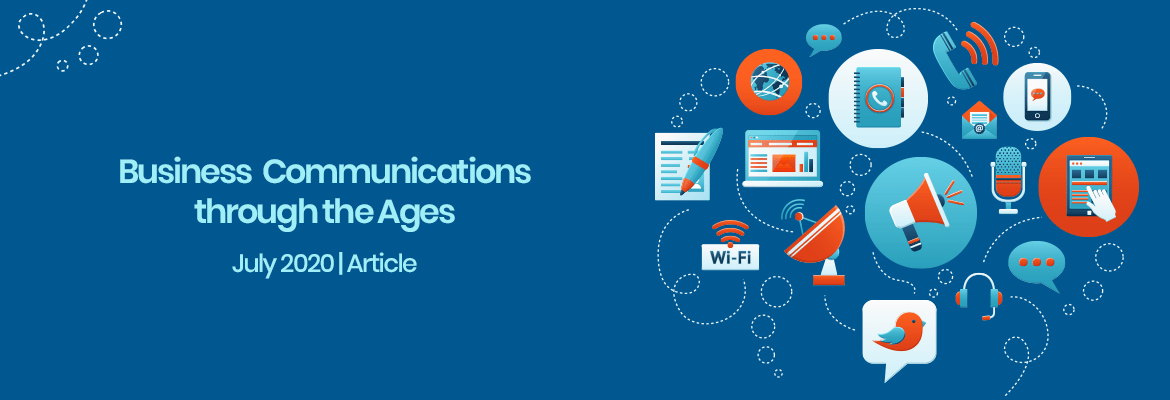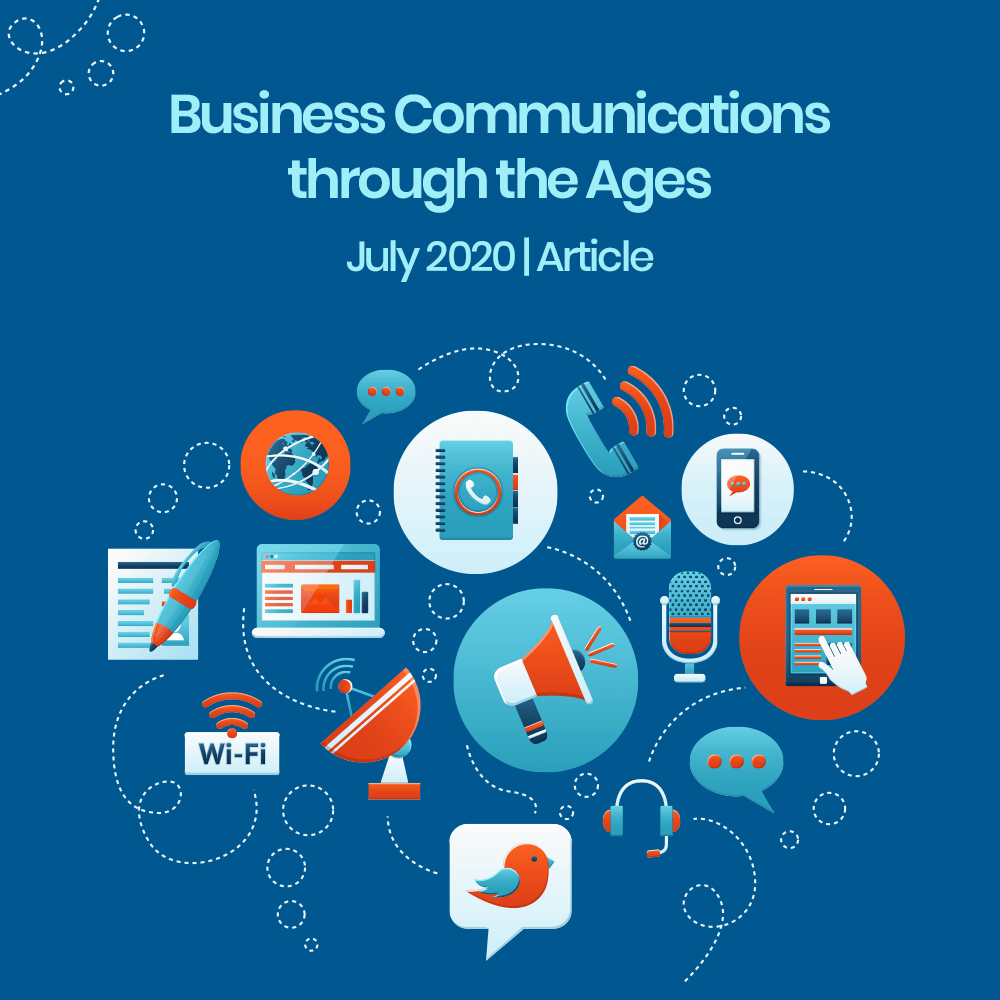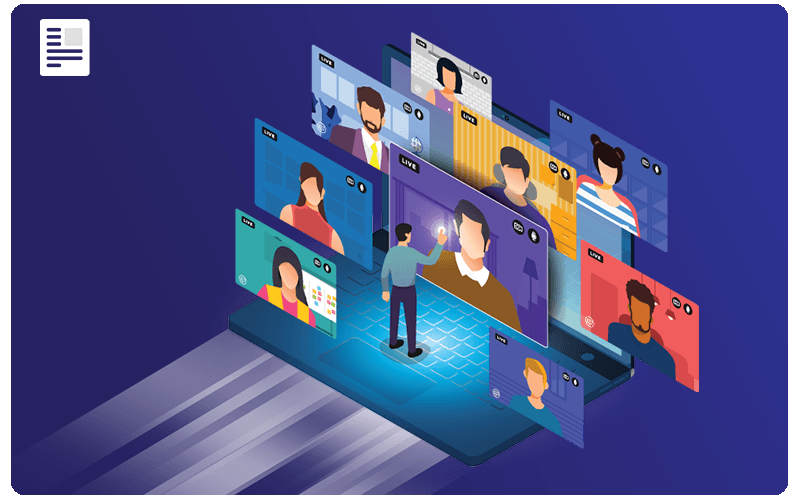

Business communication has made unprecedented strides at a whirlwind pace over the last few centuries. From smoke signals and runners delivering business contracts, to letters through water and air travel, and finally having access to an omnichannel range of communication tools like chatbots, messaging apps, videoconferencing apps, etc; we have come a long way. Organizations have always been dependent on technology and as their needs grew, each version of the industrial revolution that has emerged over the years has been an upgraded version to cater to an ever-evolving communications landscape. While we’ve made extraordinary progress since then, the principles of business communications have remained rooted in simplifying and enhancing communication processes. We reflect on the disruptive communication technologies of the past that have largely revolved around textual communications and then evolved into voice and eventually reached video. Today we benefit from an amalgamation of all three modes that deliver seamless communications, replacing the singular channel of communication that existed before. A cloud-shaped key unlocks the door to a world where the conflict between the physical and digital worlds finds harmony — a place where complexities surrounding distance, budget and time are eased.
Geographical immobility? Never heard of that.
Inventors in the 1840s made a breakthrough in business communications through the telegraph, a wire or electric device used for sending messages called telegrams. It allowed for instantaneous communication between two points at the speed of shifting electrons rather than galloping horses or the sea’s waves dictating how long it would take for a message to travel. However, the collaboration between colleagues, customers, and potential business partners was still very inconvenient since the messages had to be collected from a special telegraph office. The message time was, therefore, longer for anyone who did not have a telegraph office on-site. Today, immobility and inaccessibility are not major challenges for businesses because cloud communication tools break down the barriers between employers and employees, organizations and vendors, and businesses and their customers in different departments and locations. The cloud facilitates the shift to internet-based voice and data communication which enables employees to collaborate better by utilizing real-time chat and voice call features. Data sharing and notes can now be shared easily over the internet through a combination of video, text, voice, graphics, and live conferencing. CPaaS (as its collectively called nowadays) solutions allow technology leaders to share their expertise with employees and trainees anywhere in the world because they are supported by communication APIs that support speedy communication.
Everybody eats
The telegraph may have been a major innovation back then but it was expensive and only accessible to government agencies and individuals with large business firms. Therefore, the affordability was out of their reach and the average person could only dream of starting a business. Now, the cloud gives small businesses a competitive edge which allows them to compete with bigger organizations and take a shot with their own start-ups. The cloud allows individuals and small businesses the same communication possibilities open for governments and other large organizations. By communications being more cost-effective now, businesses can start small and grow with time, and simultaneously lower overall operational costs. Since cloud services are self-managed, small businesses typically don’t need to invest in IT infrastructure to set up their communication systems or in the case of the 1840s, travel to special telegraph offices to receive simple messages. Cloud communication solutions can be customized to any business size which gives small players in the game the advantage of scalability, as well as profitability. CPaaS adoption enables communication capabilities like sending texts and notifications and eliminate the need for purchasing pricey communication platforms.
Buy 1 get 3 free:
(i) Panoramic
Typewriters became common in workplaces after the mid-1880s and had a broad impact on the layout of offices and how organizations exchanged information, documents, and contracts. For the first time ever, people were allowed to express their ideas on paper but the physical immobility of the machinery back in the 19th century required different types of office spaces and employees (typists, stenographers, clerks). The office spaces and tools of today have been completed rearranged but we owe most of their legacy to past technologies. For instance, with the advent of technologies with all-in-one capabilities, i.e.- laptops; typewriters became redundant. But the design and use are somewhat (if not completely) similar – a keyboard with a front-facing view of what you are typing. The problem with typewriters was it needed rooms for filing papers, to put binders, and unique desk space to place it on. The way this design is used differently now is linked to how we have pervasive access to Wi-Fi and 4G. Wireless broadband connects us to the internet and as a result, our entire workplace through a computer screen.
(ii) Paperless
The business impact of switching to paperless communication also manifests itself in terms of saving costs, efficiency, and increased environmental responsibility. Organizations that have successfully gone paperless use emails instead of paper communication. Most employees today also add a message at the bottom of their email discouraging printing the mail unless absolutely necessary. Communication with employees, vendors, and customers can now be done through an organization’s website, company intranet, and social media platforms. Online blogs and forums can be used to distribute documents, budgets, forms, and company policies. Moreover, documents can be scanned and downloaded to the cloud with the availability of e-signatures as well making typewriters highly replaceable. Through word processing software such as Microsoft Word and Google Docs available on everyone’s laptops, phones, and tablets; workplace communications today can be done remotely on portable devices.
(iii) Pandemic friendly
Although the first two industrial revolutions laid down the foundations of technology for the tools we rely on today and made great progress in the right direction, the living and working conditions remained below par. Industrial towns were overcrowded and disease-ridden and ultimately led to the world’s first modern pandemic — the cholera outbreak. Not only did it compromise the health and life of workers, but it also severed many business ties and decreased overall worker productivity too. There were no available business modes of communications back then to support remote work during the quarantine. Typewriters were a standard fixture and required physical presence at offices since business correspondence was done on paper. Presently, we are under yet another pandemic. But the difference between the present and the past is in the way organizations communicate now. Cloud makes remote work possible through cloud-based platforms that enable chat, audio, and video conferencing, making almost every business correspondence digital. The virtual office and virtual team are on course to become the standard working model in the future. In addition to working anywhere and anytime, it strengthens efficiency and improves the quality of output too. Recently Metova surveyed employees working from home during COVID-19 and found that 48% of employees said they were more productive working from home. 76% of them also admitted to using video conferencing as part of their daily work. The resources at our disposal today, thanks to the cloud, have allowed us to keep the lines of communication open. Companies now have the ability to decentralize their sales force and hire talented full-time employees from anywhere. Cloud Communications keep business communication functional round the clock, no matter what disease the world is suffering from.
Hello, is it me you’re looking for?
After the telephone was introduced to organizations, there was a shift from only textual forms of communications to voice as well, which changed the way organizations communicated forever. The technology allowed for convenient and relatively cheaper communication across far regions. It was definitely an update from the expensive and inaccessible telegraph. However, it was still largely unavailable to a majority of households and developing countries. Moreover, it did not provide a large number of people to communicate simultaneously together. There were still limits to the way businesses interacted. The second industrial revolution, also known as the technological revolution, didn’t know what the fourth industrial revolution, the era of digital transformation, had in store for them. Today, cloud communication tools eliminate the need for a traditional desk phone system. The need for constant maintenance or hardware upgrades with traditional landline phones are eliminated with the cloud. Cloud-based peer-to-peer software platforms provide videotelephony and online chat services that make teleconferencing and telecommuting easy. It also supports remote work because the system is all on one platform.
That’s so 1956
Remember the fax machine? It was one of the main advancements of the third industrial revolution, also known as the digital revolution, and was the first commercialized version of the fax machine as we know it today. A fax machine is connected to a landline phone number that transmits information on a computer screen and almost instantly sends the message across to a fax machine on the other hand on paper. While they do sound charming and retro at first glance, they can actually pose a few problems. Apart from needing constant maintenance, fax systems are security risks, don’t support multitasking, and aren’t environmentally friendly either. Gartner estimates that $22 billion to $32 billion is spent every year on simply filing, storing, and accessing paper, in the US alone. Leading consultancies suggest organizations to go paperless and fax machines make going green impossible. In contrast, cloud-based email offers a far more efficient combination of scalability and flexibility for organizations. For instance, hospitals and public health care organizations have seen an improvement in replacing faxing with a more efficient and secure patient record exchange such as cloud-enabled direct messaging platforms and health information exchanges. This way information can be accessed from anywhere, on any device, which makes it a suitable mode of communication for remote workers too. In addition, emails make team collaboration seamless too now with the work being uninterrupted due to maintenance, like in the case of faxes. And above all, the cloud digitalizes storage and mails which reduces the negative impact profusely printed papers have on the environment. Whereas, CPaaS services are the connective tissue of these remote servers keeping you connected 24/7.
Get with the times; The TransformX way
The TransformX approach is aligned with the cloud approach in enabling organizations to rethink and revolutionize the way they communicate by adopting futuristic technology. Today, we have a sturdy combination of technological advancements in the form of artificial intelligence, robotics, IoT, and other cutting-edge technologies. These have served as catalysts for the development and deployment of efficient business communications. A perfect storm of technologies is carrying forward the 4th industrial revolution and at TransformX we help you pave the way for transformative and disruptive ways to advance your business. The TransformX approach enables organizations in rethinking customer experience through innovative and disruptive methods of communication. Our signature Cloud Communications offering helps clients carefully select new CPaaS solutions (or replace existing ones) as a result of a deep study of organizational, functional, and technical dynamics. A comprehensive review of the merits and demerits of the existing CPaaS solution(s) is also offered along with CPaaS program oversight initiatives. We look forward to assisting you in your digital and customer transformation journey by combining elements of the above mentioned Cloud Communications sub offerings — New CpaaS Acquisition, Existing CPaaS Review, and CPaaS Program Oversight. We help you make decisions that are customer-driven and identify the gaps in your customer approach to better your services. Start your customer-centric journey with us now! Together we can continue evolving and improving upon our organizational practices and make a name for ourselves in history; connect with us now!
Business communication has made unprecedented strides at a whirlwind pace over the last few centuries. From smoke signals and runners delivering business contracts, to letters through water and air travel, and finally having access to an omnichannel range of communication tools like chatbots, messaging apps, videoconferencing apps, etc; we have come a long way. Organizations have always been dependent on technology and as their needs grew, each version of the industrial revolution that has emerged over the years has been an upgraded version to cater to an ever-evolving communications landscape. While we’ve made extraordinary progress since then, the principles of business communications have remained rooted in simplifying and enhancing communication processes. We reflect on the disruptive communication technologies of the past that have largely revolved around textual communications and then evolved into voice and eventually reached video. Today we benefit from an amalgamation of all three modes that deliver seamless communications, replacing the singular channel of communication that existed before. A cloud-shaped key unlocks the door to a world where the conflict between the physical and digital worlds finds harmony — a place where complexities surrounding distance, budget, and time are eased.
Geographical immobility? Never heard of that.
Inventors in the 1840s made a breakthrough in business communications through the telegraph, a wire or electric device used for sending messages called telegrams. It allowed for instantaneous communication between two points at the speed of shifting electrons rather than galloping horses or the sea’s waves dictating how long it would take for a message to travel. However, the collaboration between colleagues, customers, and potential business partners was still very inconvenient since the messages had to be collected from a special telegraph office. The message time was, therefore, longer for anyone who did not have a telegraph office on-site. Today, immobility and inaccessibility are not major challenges for businesses because cloud communication tools break down the barriers between employers and employees, organizations and vendors, and businesses and their customers in different departments and locations. The cloud facilitates the shift to internet-based voice and data communication which enables employees to collaborate better by utilizing real-time chat and voice call features. Data sharing and notes can now be shared easily over the internet through a combination of video, text, voice, graphics, and live conferencing. CPaaS (as its collectively called nowadays) solutions allow technology leaders to share their expertise with employees and trainees anywhere in the world because they are supported by communication APIs that support speedy communication.
Everybody eats
The telegraph may have been a major innovation back then but it was expensive and only accessible to government agencies and individuals with large business firms. Therefore, the affordability was out of their reach and the average person could only dream of starting a business. Now, the cloud gives small businesses a competitive edge which allows them to compete with bigger organizations and take a shot with their own start-ups. The cloud allows individuals and small businesses the same communication possibilities open for governments and other large organizations. By communications being more cost-effective now, businesses can start small and grow with time, and simultaneously lower overall operational costs. Since cloud services are self-managed, small businesses typically don’t need to invest in IT infrastructure to set up their communication systems or in the case of the 1840s, travel to special telegraph offices to receive simple messages. Cloud communication solutions can be customized to any business size which gives small players in the game the advantage of scalability, as well as profitability. CPaaS adoption enables communication capabilities like sending texts and notifications and eliminate the need for purchasing pricey communication platforms.
Buy 1 get 3 free:
(i) Panoramic
Typewriters became common in workplaces after the mid-1880s and had a broad impact on the layout of offices and how organizations exchanged information, documents, and contracts. For the first time ever, people were allowed to express their ideas on paper but the physical immobility of the machinery back in the 19th century required different types of office spaces and employees (typists, stenographers, clerks). The office spaces and tools of today have been completed rearranged but we owe most of their legacy to past technologies. For instance, with the advent of technologies with all-in-one capabilities, i.e.- laptops; typewriters became redundant. But the design and use are somewhat (if not completely) similar – a keyboard with a front-facing view of what you are typing. The problem with typewriters was it needed rooms for filing papers, to put binders, and unique desk space to place it on. The way this design is used differently now is linked to how we have pervasive access to Wi-Fi and 4G. Wireless broadband connects us to the internet and as a result, our entire workplace through a computer screen.
(ii) Paperless
The business impact of switching to paperless communication also manifests itself in terms of saving costs, efficiency, and increased environmental responsibility. Organizations that have successfully gone paperless use emails instead of paper communication. Most employees today also add a message at the bottom of their email discouraging printing the mail unless absolutely necessary. Communication with employees, vendors, and customers can now be done through an organization’s website, company intranet, and social media platforms. Online blogs and forums can be used to distribute documents, budgets, forms, and company policies. Moreover, documents can be scanned and downloaded to the cloud with the availability of e-signatures as well making typewriters highly replaceable. Through word processing software such as Microsoft Word and Google Docs available on everyone’s laptops, phones, and tablets; workplace communications today can be done remotely on portable devices.
(iii) Pandemic friendly
Although the first two industrial revolutions laid down the foundations of technology for the tools we rely on today and made great progress in the right direction, the living and working conditions remained below par. Industrial towns were overcrowded and disease-ridden and ultimately led to the world’s first modern pandemic — the cholera outbreak. Not only did it compromise the health and life of workers, but it also severed many business ties and decreased overall worker productivity too. There were no available business modes of communications back then to support remote work during the quarantine. Typewriters were a standard fixture and required physical presence at offices since business correspondence was done on paper. Presently, we are under yet another pandemic. But the difference between the present and the past is in the way organizations communicate now. Cloud makes remote work possible through cloud-based platforms that enable chat, audio, and video conferencing, making almost every business correspondence digital. The virtual office and virtual team are on course to become the standard working model in the future. In addition to working anywhere and anytime, it strengthens efficiency and improves the quality of output too. Recently Metova surveyed employees working from home during COVID-19 and found that 48% of employees said they were more productive working from home. 76% of them also admitted to using video conferencing as part of their daily work. The resources at our disposal today, thanks to the cloud, have allowed us to keep the lines of communication open. Companies now have the ability to decentralize their sales force and hire talented full-time employees from anywhere. Cloud Communications keep business communication functional round the clock, no matter what disease the world is suffering from.
Hello, is it me you’re looking for?
After the telephone was introduced to organizations, there was a shift from only textual forms of communications to voice as well, which changed the way organizations communicated forever. The technology allowed for convenient and relatively cheaper communication across far regions. It was definitely an update from the expensive and inaccessible telegraph. However, it was still largely unavailable to a majority of households and developing countries. Moreover, it did not provide a large number of people to communicate simultaneously together. There were still limits to the way businesses interacted. The second industrial revolution, also known as the technological revolution, didn’t know what the fourth industrial revolution, the era of digital transformation, had in store for them. Today, cloud communication tools eliminate the need for a traditional desk phone system. The need for constant maintenance or hardware upgrades with traditional landline phones are eliminated with the cloud. Cloud-based peer-to-peer software platforms provide videotelephony and online chat services that make teleconferencing and telecommuting easy. It also supports remote work because the system is all on one platform.
That’s so 1956
Remember the fax machine? It was one of the main advancements of the third industrial revolution, also known as the digital revolution, and was the first commercialized version of the fax machine as we know it today. A fax machine is connected to a landline phone number that transmits information on a computer screen and almost instantly sends the message across to a fax machine on the other hand on paper. While they do sound charming and retro at first glance, they can actually pose a few problems. Apart from needing constant maintenance, fax systems are security risks, don’t support multitasking, and aren’t environmentally friendly either. Gartner estimates that $22 billion to $32 billion is spent every year on simply filing, storing, and accessing paper, in the US alone. Leading consultancies suggest organizations to go paperless and fax machines make going green impossible. In contrast, cloud-based email offers a far more efficient combination of scalability and flexibility for organizations. For instance, hospitals and public health care organizations have seen an improvement in replacing faxing with a more efficient and secure patient record exchange such as cloud-enabled direct messaging platforms and health information exchanges. This way information can be accessed from anywhere, on any device, which makes it a suitable mode of communication for remote workers too. In addition, emails make team collaboration seamless too now with the work being uninterrupted due to maintenance, like in the case of faxes. And above all, the cloud digitalizes storage and mails which reduces the negative impact profusely printed papers have on the environment. Whereas, CPaaS services are the connective tissue of these remote servers keeping you connected 24/7.
Get with the times; The TransformX way
The TransformX approach is aligned with the cloud approach in enabling organizations to rethink and revolutionize the way they communicate by adopting futuristic technology. Today, we have a sturdy combination of technological advancements in the form of artificial intelligence, robotics, IoT, and other cutting-edge technologies. These have served as catalysts for the development and deployment of efficient business communications. A perfect storm of technologies is carrying forward the 4th industrial revolution and at TransformX we help you pave the way for transformative and disruptive ways to advance your business. The TransformX approach enables organizations in rethinking customer experience through innovative and disruptive methods of communication. Our signature Cloud Communications offering helps clients carefully select new CPaaS solutions (or replace existing ones) as a result of a deep study of organizational, functional, and technical dynamics. A comprehensive review of the merits and demerits of the existing CPaaS solution(s) is also offered along with CPaaS program oversight initiatives. We look forward to assisting you in your digital and customer transformation journey by combining elements of the above mentioned Cloud Communications sub offerings — New CpaaS Acquisition, Existing CPaaS Review, and CPaaS Program Oversight. We help you make decisions that are customer-driven and identify the gaps in your customer approach to better your services. Start your customer-centric journey with us now! Together we can continue evolving and improving upon our organizational practices and make a name for ourselves in history; connect with us now!




